Unveiling the Non-Linear Influence of Eye-Level Streetscape Factors on Walking Preference: Evidence from Tokyo
Abstract
:1. Introduction
2. Literature Review
3. Materials and Methods
3.1. Case Study Site and Study Scope
3.2. Study Scope
3.3. Analysis Framework
3.4. Data Preparation
3.5. Dependent Variables: Walking Preference Scores
3.5.1. Image Survey Data Preparation
3.5.2. Walking Preference Surveying
3.5.3. Prediction-Model Training
3.5.4. Prediction Model Application
3.6. Independent Variables: Eye-Level Streetscape Factors
3.6.1. Selection of Eye-Level Streetscape Factors
3.6.2. Quantification of Eye-Level Factors
3.7. XGBoost Regression Analysis
4. Results
4.1. Results of XGBoost Model Training
4.2. Results for Relative Importance
4.3. PDP Results
4.3.1. Skeletal Streetscapes in Segment Sections
4.3.2. Detailed Streetscapes in Street Segments
4.3.3. Skeletal Streetscapes in Street Intersections
4.3.4. Detailed Streetscapes in Street Intersections
5. Discussion
6. Conclusions
Author Contributions
Funding
Data Availability Statement
Conflicts of Interest
References
- Tokyo Metropolitan Government. Tokyo Sustainability Action 2023. Available online: https://www.metro.tokyo.lg.jp/english/about/sustainable/documents/tokyo_sustainability_action2023.pdf (accessed on 3 February 2024).
- Hu, F.B.; Sigal, R.J.; Rich-Edwards, J.W.; Colditz, G.A.; Solomon, C.G.; Willett, W.C.; Speizer, F.E.; Manson, J.E. Walking compared with vigorous physical activity and risk of type 2 diabetes in women: A prospective study. JAMA 1999, 282, 1433–1439. [Google Scholar] [CrossRef]
- Hu, H.B.; Stampfer, M.J.; Solomon, C.; Liu, S.; Colditz, G.A.; Speizer, F.E.; Willett, W.C.; Manson, J.E. Physical activity and risk for cardiovascular events in diabetic women. Ann. Intern. Med. 2001, 134, 96–105. [Google Scholar] [CrossRef]
- Williams, P.T.; Thompson, P.D. Walking versus running for hypertension, cholesterol, and diabetes mellitus risk reduction. Arterioscler. Thromb. Vasc. Biol. 2013, 33, 1085–1091. [Google Scholar] [CrossRef] [PubMed]
- Hu, G.; Jousilahti, P.; Borodulin, K.; Barengo, N.C.; Lakka, T.A.; Nissinen, A.; Tuomilehto, J. Occupational, commuting and leisure-time physical activity in relation to coronary heart disease among middle-aged Finnish men and women. Atherosclerosis 2007, 194, 490–497. [Google Scholar] [CrossRef] [PubMed]
- Cavill, N.; Kahlmeier, S.; Rutter, H.; Racioppi, F.; Oja, P. Economic Assessment of Transport Infrastructure and Policies Methodological Guidance on the Economic Appraisal of Health Effects Related to Walking and Cycling; WHO Regional Office for Europe: Copenhagen, Denmark, 2007. [Google Scholar]
- Sung, H.; Doohwan, C.G.; Cheon, S.; Park, S. Effects of street-level physical environment and zoning on walking activity in Seoul, Korea. Land Use Policy 2015, 49, 152–160. [Google Scholar] [CrossRef]
- Sarkar, C.; Webster, C.; Pryor, M.; Tang, D.; Melbourne, S.; Zhang, X.; Jianzheng, L. Exploring associations between urban green, street design and walking: Results from the Greater London boroughs. Landsc. Urban Plan. 2015, 143, 112–125. [Google Scholar] [CrossRef]
- Alfonzo, M.A. To walk or not to walk? The hierarchy of walking needs. Environ. Behav. 2005, 37, 808–836. [Google Scholar] [CrossRef]
- Millstein, R.A.; Cain, K.L.; Sallis, J.F.; Conway, T.L.; Geremia, C.; Frank, L.D.; Chapman, J.; Van Dyck, D.; Dipzinski, L.R.; Kerr, J.; et al. Development, scoring, and reliability of the Microscale Audit of Pedestrian Streetscapes (MAPS). BMC Public Health 2013, 13, 403. [Google Scholar] [CrossRef]
- Borst, H.C.; Vries, S.I.; Graham, J.M.; van Dongen, J.E.; Bakker, I.; Miedema, H.M. Influence of environmental street characteristics on walking route choice of elderly people. J. Environ. Psychol. 2009, 29, 477–484. [Google Scholar] [CrossRef]
- Shatu, F.; Yigitcanlar, T.; Bunker, J. Shortest path distance vs. least directional change: Empirical testing of space syntax and geographic theories concerning pedestrian route choice behaviour. J. Transp. Geogr. 2019, 74, 37–52. [Google Scholar] [CrossRef]
- Basu, R.; Sevtsuk, A. How do street attributes affect willingness-to-walk? City-wide pedestrian route choice analysis using big data from Boston and San Francisco. Transp. Res. A Policy Pract. 2022, 163, 1–19. [Google Scholar] [CrossRef]
- Guzman, L.A.; Arellana, J.; Castro, W.F. Desirable streets for pedestrians: Using a street-level index to assess walkability. Transp. Res. D Trans. Environ. 2022, 111, 103462. [Google Scholar] [CrossRef]
- Nagata, S.; Hanibuchi, T.; Amagasa, S.; Kikuchi, H.; Inoue, S. Objective scoring of streetscape walkability related to leisure walking: Statistical modeling approach with semantic segmentation of Google Street View images. Health Place 2020, 66, 102428. [Google Scholar] [CrossRef] [PubMed]
- Boarnet, M.G.; Day, K.; Alfonzo, M.; Forsyth, A.; Oakes, M. The Irvine–Minnesota Inventory to Measure Built Environments: Reliability Tests. Am. J. Prev. Med. 2006, 30, 153–159. [Google Scholar] [CrossRef] [PubMed]
- Harvey, C.; Aultman-Hall, L.; Stephanie, E.; Austin, T.; Hurley, S.E. Effects of skeletal streetscape design on perceived safety. Landsc. Urban Plan. 2015, 142, 18–28. [Google Scholar] [CrossRef]
- Cervero, R.; Kockelman, K. Travel demand and the 3Ds: Density, diversity, and design. Transp. Res. D Trans. Environ. 1997, 2, 199–219. [Google Scholar] [CrossRef]
- Cervero, R.; Sarmiento, O.L.; Jacoby, E.; Gomez, L.F.; Neiman, A. Influences of built environments on walking and cycling: Lessons from Bogotá. Int. J. Sustain. Transp. 2009, 3, 203–226. [Google Scholar] [CrossRef]
- Handy, S.L.; Boarnet, M.G.; Ewing, R.; Killingsworth, R.E. How the built environment affects physical activity: Views from urban planning. Am. J. Prev. Med. 2002, 23, 64–73. [Google Scholar] [CrossRef] [PubMed]
- Brownson, R.C.; Hoehner, C.M.; Brennan, L.K.; Cook, R.A.; Elliott, M.B.; McMullen, K.M. Reliability of 2 instruments for auditing the environment for physical activity. J. Phys. Act. Health 2004, 1, 191–208. [Google Scholar] [CrossRef]
- Belza, B.; Altpeter, M.; Smith, M.L.; Ory, M.G. The Healthy Aging Research Network: Modeling Collaboration for Community Impact. Am. J. Prev. Med. 2017, 52, S228–S232. [Google Scholar] [CrossRef] [PubMed]
- Emery, J.; Crump, C.; Bors, P. Reliability and validity of two instruments designed to assess the walking and bicycling suitability of sidewalks and roads. Am. J. Health Promot. 2003, 18, 38–46. [Google Scholar] [CrossRef] [PubMed]
- Evenson, K.R.; Sotres-Alvarez, D.; Herring, A.H.; Messer, L.; Laraia, B.A.; Rodríguez, D.A. Assessing urban and rural neighborhood characteristics using audit and GIS data: Derivation and reliability of constructs. Int. J. Behav. Nutr. Phys. Act. 2009, 6, 44. [Google Scholar] [CrossRef] [PubMed]
- Aghaabbasi, M.; Moeinaddini, M.; Shah, M.Z.; Asadi-Shekari, Z.A. A new assessment model to evaluate the microscale sidewalk design factors at the neighbourhood level. J. Transp. Health 2017, 5, 97–112. [Google Scholar] [CrossRef]
- Huang, L.; Oki, T.; Muto, S.; Kim, H.; Ogawa, Y.; Sekimoto, Y. Automatic Evaluation of Street-Level Walkability Based on Computer Vision Techniques and Urban Big Data: A Case Study of Kowloon West, Hong Kong. In Intelligence for Future Cities: Planning through Big Data and Urban Analytics; Springer Nature: Berlin/Heidelberg, Germany, 2023; pp. 231–259. [Google Scholar] [CrossRef]
- Ng, S.; Lai, C.; Liao, P.; Lao, M.; Lau, W. Measuring and Improving Walkability in Hong Kong; Civic Exchange: Hong Kong, China, 2016. [Google Scholar]
- Gallimore, J.M.; Brown, B.B.; Werner, C.M. Walking routes to school in new urban and suburban neighborhoods: An environmental walkability analysis of blocks and routes. J. Environ. Psychol. 2011, 31, 184–191. [Google Scholar] [CrossRef]
- Ewing, R.; Handy, S. Measuring the unmeasurable: Urban design qualities related to walkability. J. Urban Des. 2009, 14, 65–84. [Google Scholar] [CrossRef]
- Asgarzadeh, M.; Koga, T.; Hirate, K.; Farvid, M.; Lusk, A. Investigating oppressiveness and spaciousness in relation to building, trees, sky and ground surface: A study in Tokyo. Landsc. Urban Plan. 2014, 131, 36–41. [Google Scholar] [CrossRef]
- Asgarzadeh, M.; Lusk, A.; Koga, T.; Hirate, K. Measuring oppressiveness of streetscapes. Landsc. Urban Plan. 2012, 107, 1–11. [Google Scholar] [CrossRef]
- Adkins, A.; Luhr, G.; Neal, M. Unpacking walkability: Testing the influence of urban design features on perceptions of walking environment attractiveness. J. Urban Des. 2012, 17, 499–510. [Google Scholar] [CrossRef]
- Borst, H.C.; Miedema, H.M.; de Vries, S.I.; Graham, J.M.; van Dongen, J.E. Relationships between street characteristics and perceived attractiveness for walking reported by elderly people. J. Environ. Psychol. 2008, 28, 353–361. [Google Scholar] [CrossRef]
- Agrawal, A.W.; Schlossberg, M.; Irvin, K. How Far, by Which Route and Why? A Spatial Analysis of Pedestrian Preference. J. Urban Des. 2008, 13, 81–98. [Google Scholar] [CrossRef]
- Li, X.; Zhang, C.; Li, W. Does the visibility of greenery increase perceived safety in urban areas? Evidence from the place pulse 1.0 dataset. ISPRS Int. J. Geo-Inf. 2015, 4, 1166–1183. [Google Scholar] [CrossRef]
- Rodrigue, L.; Manaugh, K.; El-Geneidy, A.; Daley, J.; Wasfi, R.; Ravensbergen, L.; Butler, G. Factors influencing subjective walkability: Results from built environment audit data. J. Transp. Land Use 2022, 15, 709–727. [Google Scholar] [CrossRef]
- Yin, C.; Cao, J.; Sun, B.; Liu, J. Exploring built environment correlates of walking for different purposes: Evidence for substitution. J. Transp. Geogr. 2023, 106, 103505. [Google Scholar] [CrossRef]
- Tao, T.; Wu, X.; Cao, J.; Fan, Y.; Das, K.; Ramaswami, A. Exploring the nonlinear relationship between the built environment and active travel in the Twin Cities. J. Plan. Educ. Res. 2023, 43, 637–652. [Google Scholar] [CrossRef]
- Cheng, L.; De Vos, J.; Zhao, P.; Yang, M.; Witlox, F. Examining non-linear built environment effects on elderly’s walking: A random forest approach. Transp. Res. D Trans. Environ. 2020, 88, 102552. [Google Scholar] [CrossRef]
- Wu, F.; Li, W.; Qiu, W. Examining non-linear relationship between streetscape features and propensity of walking to school in Hong Kong using machine learning techniques. J. Transp. Geogr. 2023, 113, 103698. [Google Scholar] [CrossRef]
- International Affairs Division. Setagaya City Outline. Available online: https://www.city.setagaya.lg.jp/mokuji/bunka/007/d00156846_d/fil/setagayacityoutline.pdf (accessed on 11 September 2023).
- MLIT. Road Structure Order. Available online: https://www.mlit.go.jp/road/sign/kouzourei_kaisetsu.html (accessed on 26 March 2024).
- Neighborhood Street Research Group. The Creation of Roads for Coexistence Between People and Cars: Considerations for Neighborhood Street Planning; Kajima Institute Publishing Co., Ltd.: Tokyo, Japan, 1989; ISBN 978-43-0607-170-4. [Google Scholar]
- Kato, H.; Kanki, K. Effectiveness of Walkability Indicator from the perspective of Subjective Evaluation on Streets in Sprawl Urban Areas: Toward Smart Shrinking for Sprawl urban areas in North Osaka Metropolitan Region. J. City Plan. Inst. Jpn. 2019, 54, 10–19. [Google Scholar] [CrossRef]
- Kirillov, A.; He, K.; Girshick, R.; Rother, C.; Dollár, P. Panoptic segmentation. In Proceedings of the IEEE/CVF Conference on Computer Vision and Pattern Recognition, Long Beach, CA, USA, 16–17 June 2019. [Google Scholar] [CrossRef]
- Chen, T.; Guestrin, C. Xgboost: A scalable tree boosting system. In Proceedings of the 22nd ACM SIGKDD International Conference on Knowledge Discovery and Data Mining, San Francisco, CA, USA, 13–17 August 2016. [Google Scholar] [CrossRef]
- Gehl, J. Life between Buildings: Using Public Space; Van Nostrand Reinhold: New York, NY, USA, 1987. [Google Scholar]
- Ogawa, Y.; Oki, T.; Zhao, C.; Sekimoto, Y.; Shimizu, C. Evaluating the subjective perceptions of streetscapes using street-view images. Landsc. Urban Plan. 2024, 247, 105073. [Google Scholar] [CrossRef]
- Ordonez, V.; Berg, T.L. Learning high-level judgments of urban perception. In Computer Vision—ECCV 2014: 13th European Conference, Zurich, Switzerland, 6–12 September 2014, Proceedings, Part VI 13; Springer International Publishing: Berlin/Heidelberg, Germany, 2014; pp. 494–510. [Google Scholar] [CrossRef]
- Dubey, A.; Naik, N.; Parikh, D.; Raskar, R.; Hidalgo, C.A. Deep learning the city: Quantifying urban perception at a global scale. In Computer Vision—ECCV 2016: 14th European Conference, Amsterdam, The Netherlands, 11–14 October 2016, Proceedings, Part I 14; Springer International Publishing: Berlin/Heidelberg, Germany, 2016; pp. 196–212. [Google Scholar] [CrossRef]
- Oki, T.; Kizawa, S. Model for Evaluating Impression of Streets in Residential Areas Based on Image Big Data and A Large Questionnaire. J. Archit. Plan. 2022, 87, 2102–2113. [Google Scholar] [CrossRef]
- Zhang, F.; Zhou, B.; Liu, L.; Liu, Y.; Fung, H.; Lin, H.; Ratti, C. Measuring human perceptions of a large-scale urban region using machine learning. Landsc. Urban Plan. 2018, 180, 148–160. [Google Scholar] [CrossRef]
- Kang, Y.; Kim, J.; Park, J.; Lee, J. Assessment of Perceived and Physical Walkability Using Street View Images and Deep Learning Technology. ISPRS Int. J. Geogr. Inf. 2023, 12, 186. [Google Scholar] [CrossRef]
- Woo, S.; Debnath, S.; Hu, R.; Chen, X.; Liu, Z.; Kweon, I.S.; Xie, S. Convnext v2: Co-designing and scaling convnets with masked autoencoders. In Proceedings of the IEEE/CVF Conference on Computer Vision and Pattern Recognition, New Orleans, LA, USA, 18–24 June 2022. [Google Scholar] [CrossRef]
- Koo, B.W.; Guhathakurta, S.; Botchwey, N. How are neighborhood and street-level walkability factors associated with walking behaviors? A big data approach using street view images. Environ. Behav. 2022, 54, 211–241. [Google Scholar] [CrossRef]
- Qiu, W.; Li, W.; Liu, X.; Zhang, Z.; Li, X.; Huang, X. Subjective and objective measures of streetscape perceptions: Relationships with property value in Shanghai. Cities 2023, 132, 104037. [Google Scholar] [CrossRef]
- Cheng, B.; Misra, I.; Schwing, A.G.; Kirillov, A.; Girdhar, R. Masked-attention Mask Transformer for Universal Image Segmentation. In Proceedings of the IEEE/CVF Conference on Computer Vision and Pattern Recognition, New Orleans, LA, USA, 18–24 June 2022. [Google Scholar] [CrossRef]
- He, K.; Zhang, X.; Ren, S.; Sun, J. Deep residual learning for image recognition. In Proceedings of the IEEE Conference on Computer Vision and Pattern Recognition, Las Vegas, NV, USA, 26 June–1 July 2016; pp. 770–778. [Google Scholar]
- Neuhold, G.; Ollmann, T.; Rota Bulò, S.; Kontschieder, P. The Mapillary Vistas Dataset for Semantic Understanding of Street Scenes. In Proceedings of the International Conference on Computer Vision (ICCV), Venice, Italy, 22–29 October 2017. [Google Scholar]
- Zhou, B.; Zhao, H.; Puig, X.; Fidler, S.; Barriuso, A.; Torralba, A. Scene parsing through ade20k dataset. In Proceedings of the IEEE Conference on Computer Vision and Pattern Recognition, Honolulu, HI, USA, 21–26 July 2017; pp. 633–641. [Google Scholar] [CrossRef]
- Atkinson, A.B. On the measurement of inequality. J. Econ. Theory 1970, 2, 244–263. [Google Scholar] [CrossRef]
- Ashihara, Y. The Aesthetic Townscape; The MIT Press: Cambridge, MA, USA, 1984; ISBN 978-02-6251-031-8. [Google Scholar]
- Blečić, I.; Cecchini, A.; Canu, D.; Cappai, A.; Congiu, T.; Fancello, G. Evaluating the effect of urban intersections on walkability. In Computational Science and Its Applications—ICCSA 2016: 16th International Conference, Beijing, China, 4–7 July 2016; Proceedings, Part IV 16; Springer International Publishing: Berlin/Heidelberg, Germany, 2016; pp. 138–149. [Google Scholar] [CrossRef]
- Wang, K.; Akar, G. Street intersection characteristics and their impacts on perceived bicycling safety. Transp. Res. Rec. 2018, 2672, 41–54. [Google Scholar] [CrossRef]
- Toronto City Council. Toronto Complete Streets Guidelines. Available online: https://www.toronto.ca/services-payments/streets-parking-transportation/enhancing-our-streets-and-public-realm/complete-streets/complete-streets-guidelines/ (accessed on 24 September 2023).
- Chiang, Y.C.; Sullivan, W.; Larsen, L. Measuring neighborhood walkable environments: A comparison of three approaches. Int. J. Environ. Res. Public Health 2017, 14, 593. [Google Scholar] [CrossRef] [PubMed]
- City and County of Denver. Streetscape Design Manual. Available online: https://www.denvergov.org/files/assets/public/v/1/doti/documents/standards/pwes-002.0-streetscape_design_manual.pdf (accessed on 15 October 2023).
- Herrmann-Lunecke, M.G.; Mora, R.; Vejares, P. Perception of the built environment and walking in pericentral neighbourhoods in Santiago, Chile. Travel Behav. Soc. 2021, 23, 192–206. [Google Scholar] [CrossRef]
- Yang, L.; Ao, Y.; Ke, J.; Liang, Y. To walk or not to walk? Examining non-linear effects of streetscape greenery on walking propensity of older adults. J. Transp. Geogr. 2021, 94, 103099. [Google Scholar] [CrossRef]
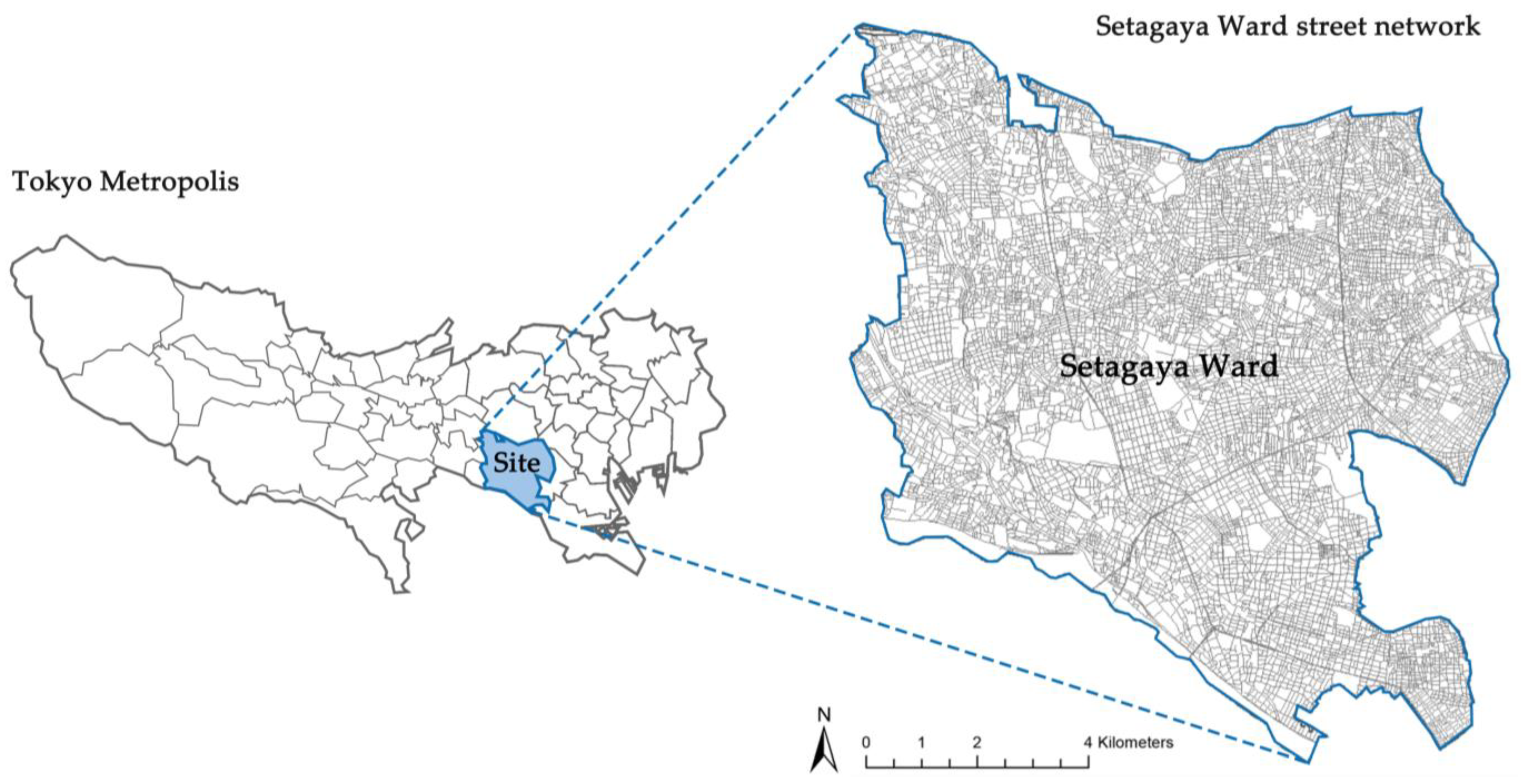
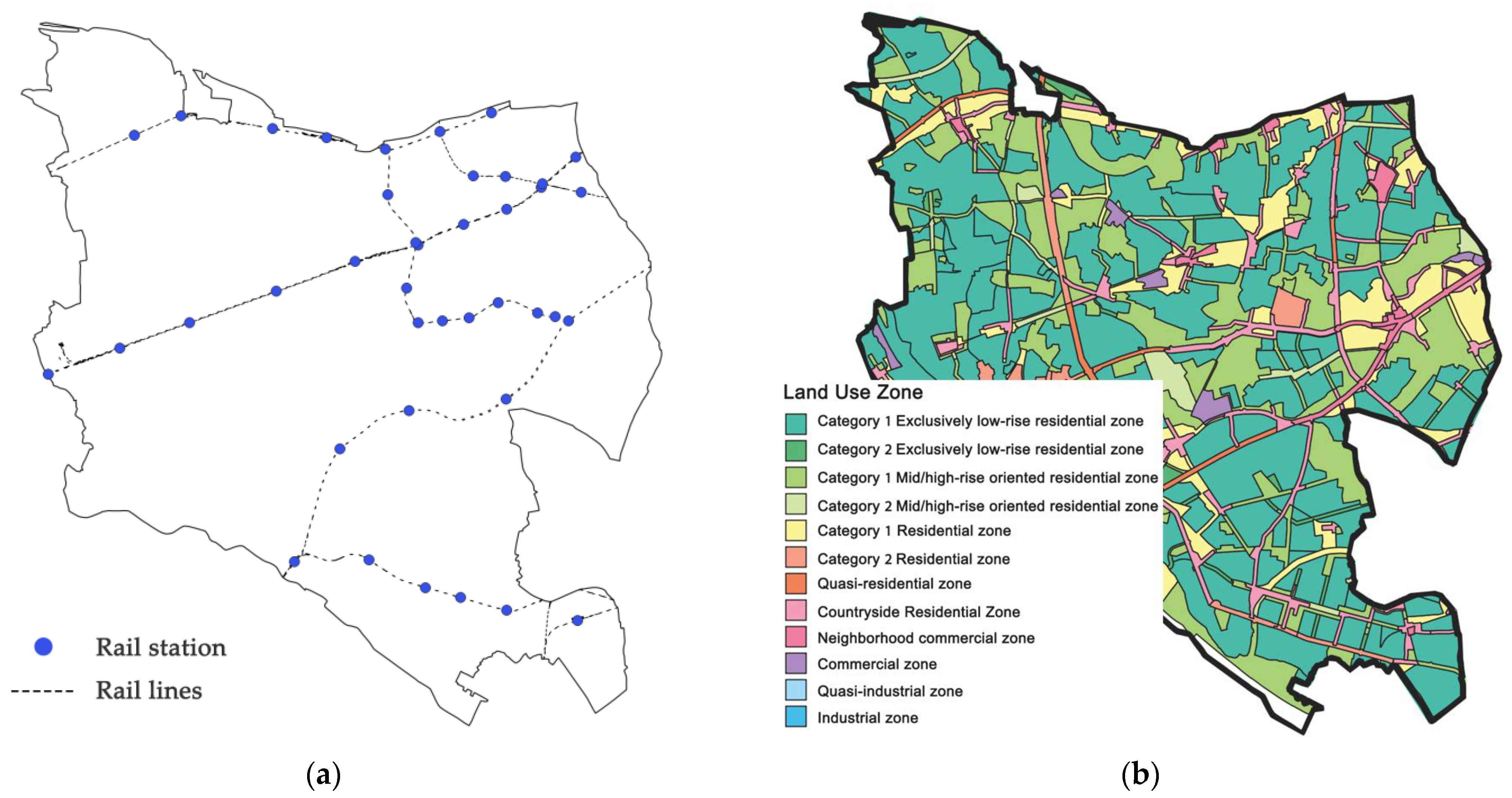
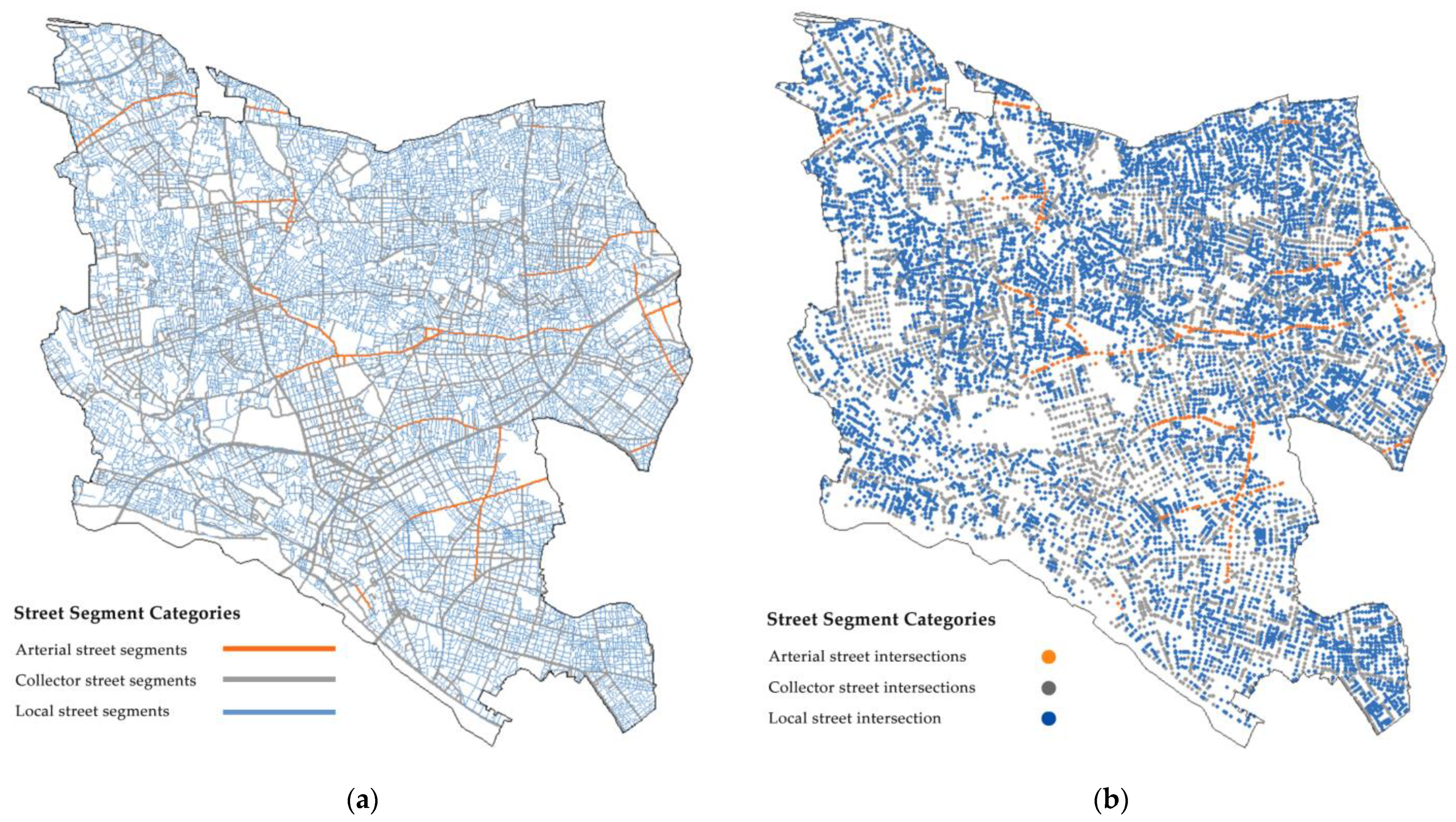
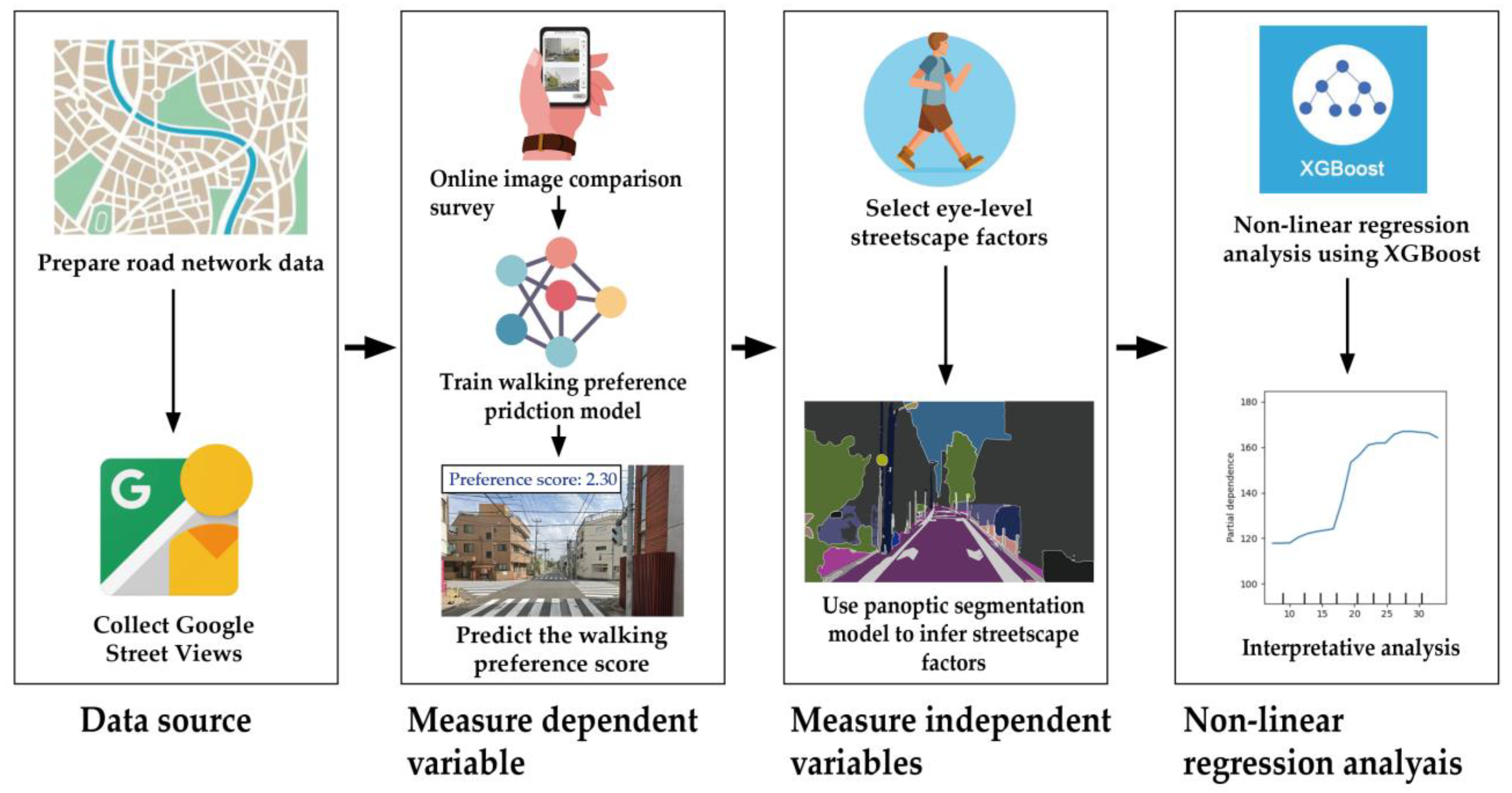

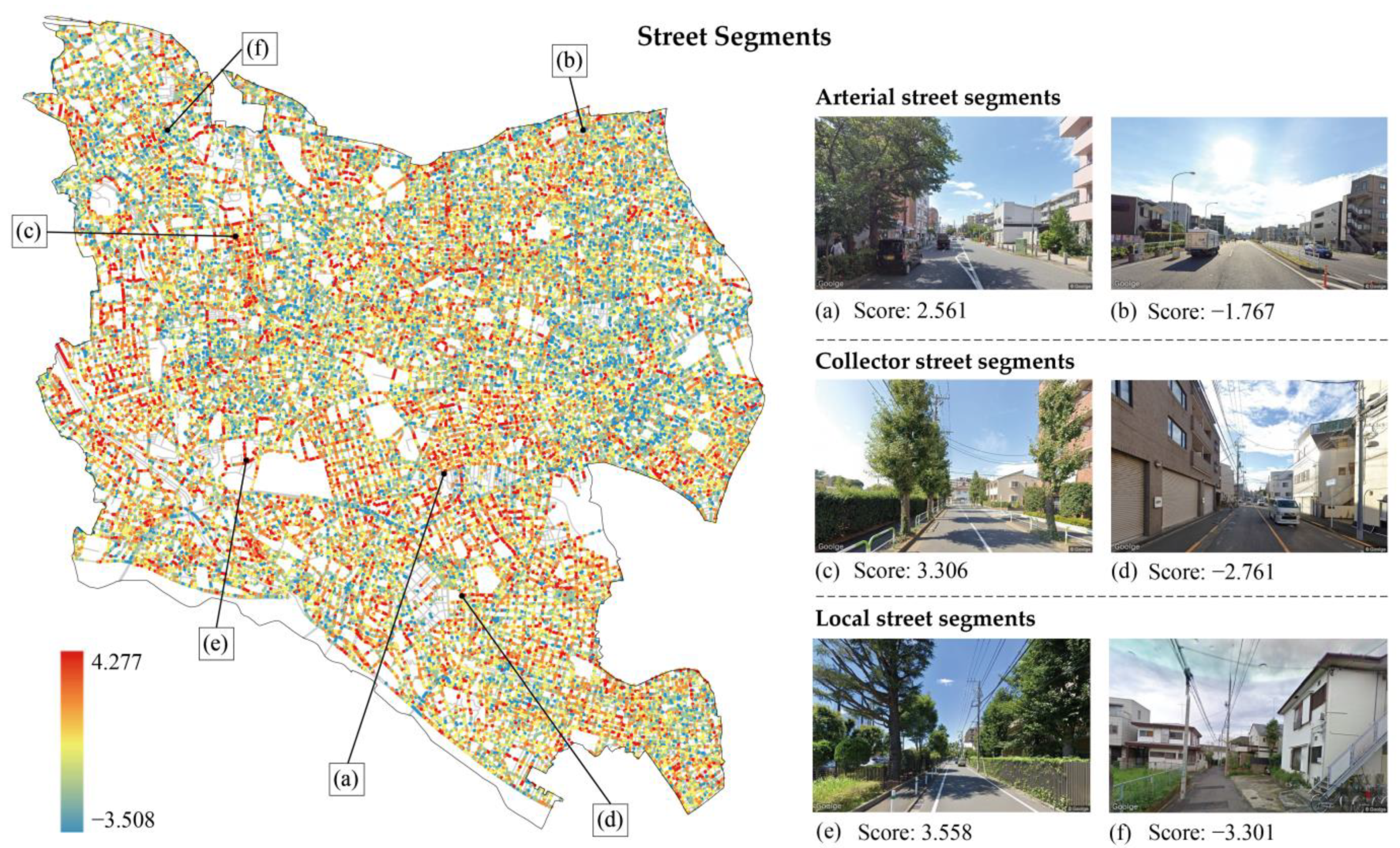
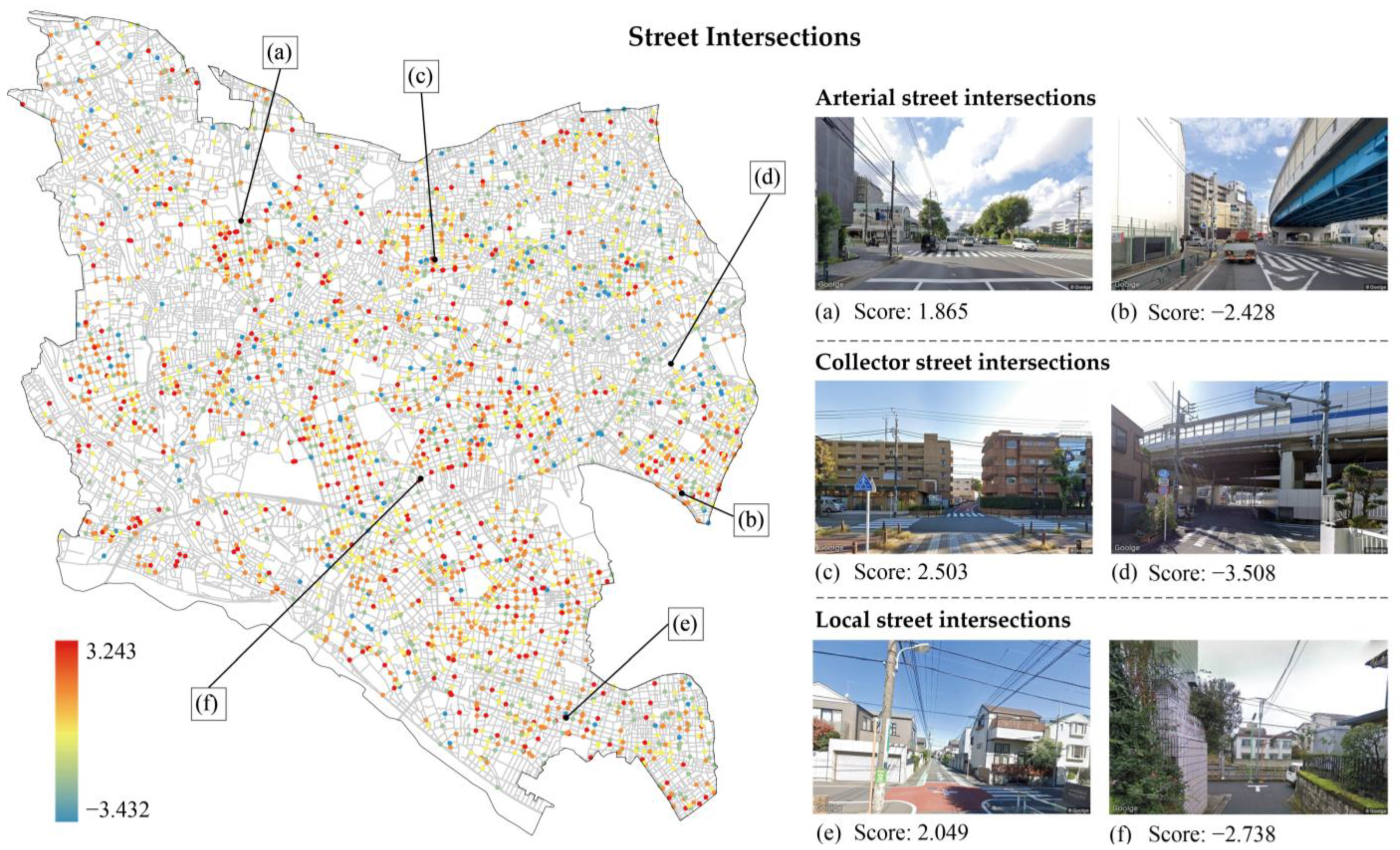
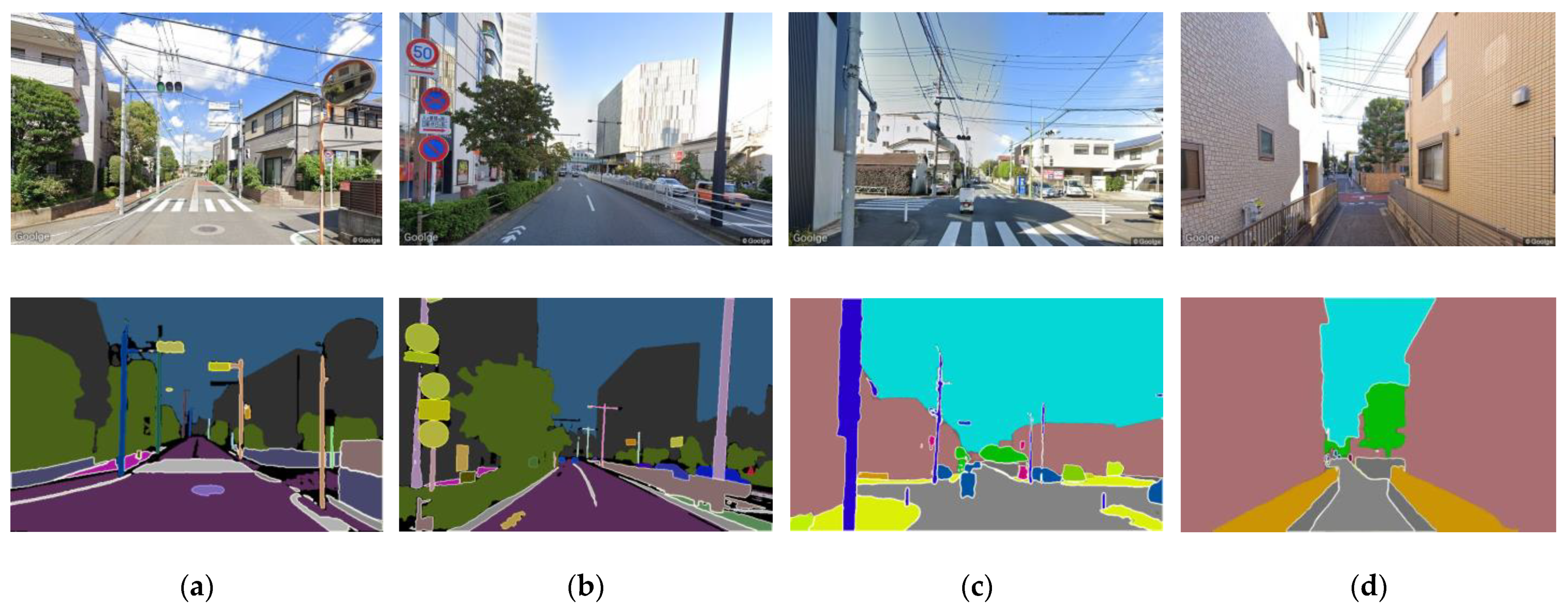
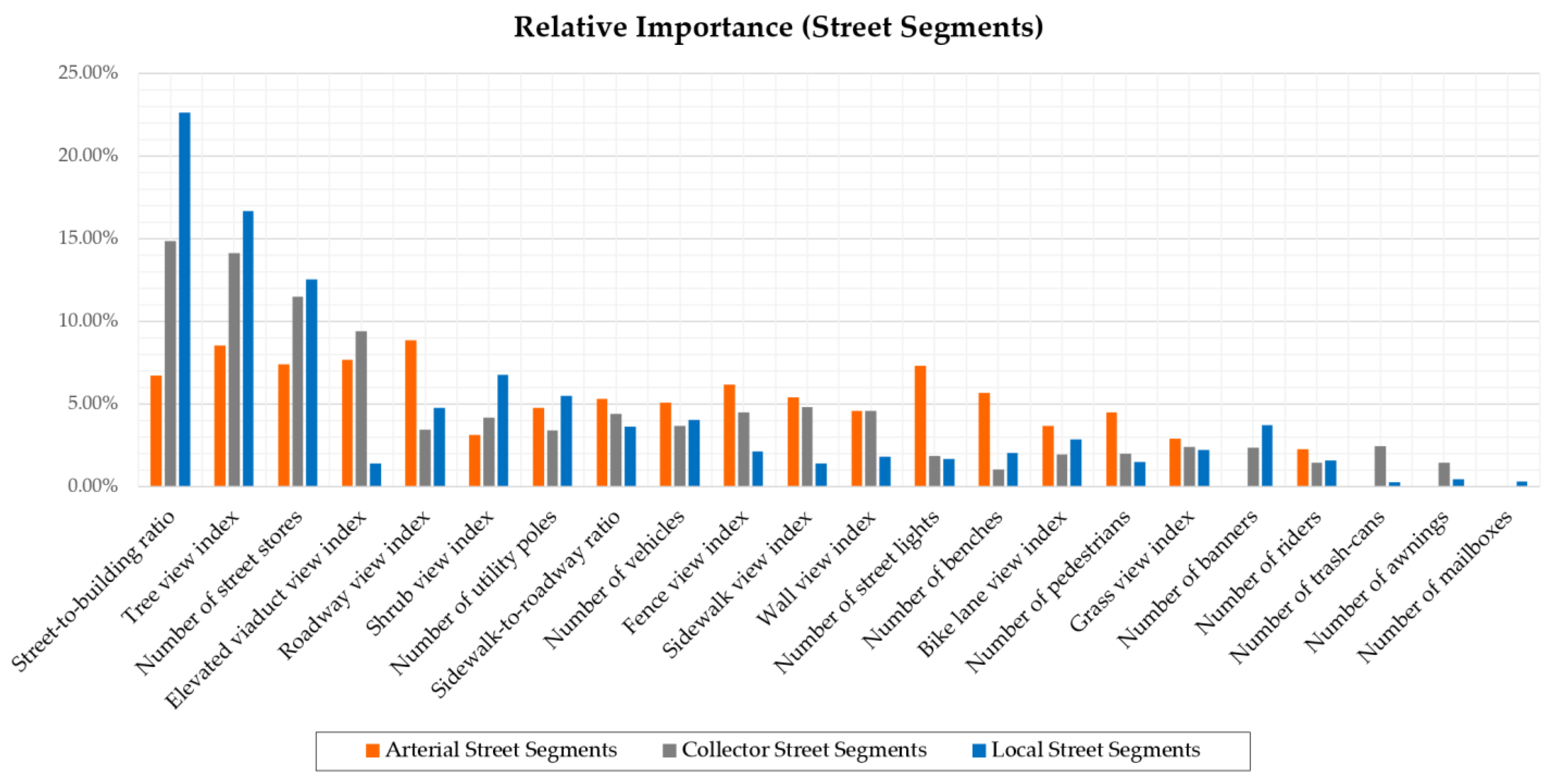
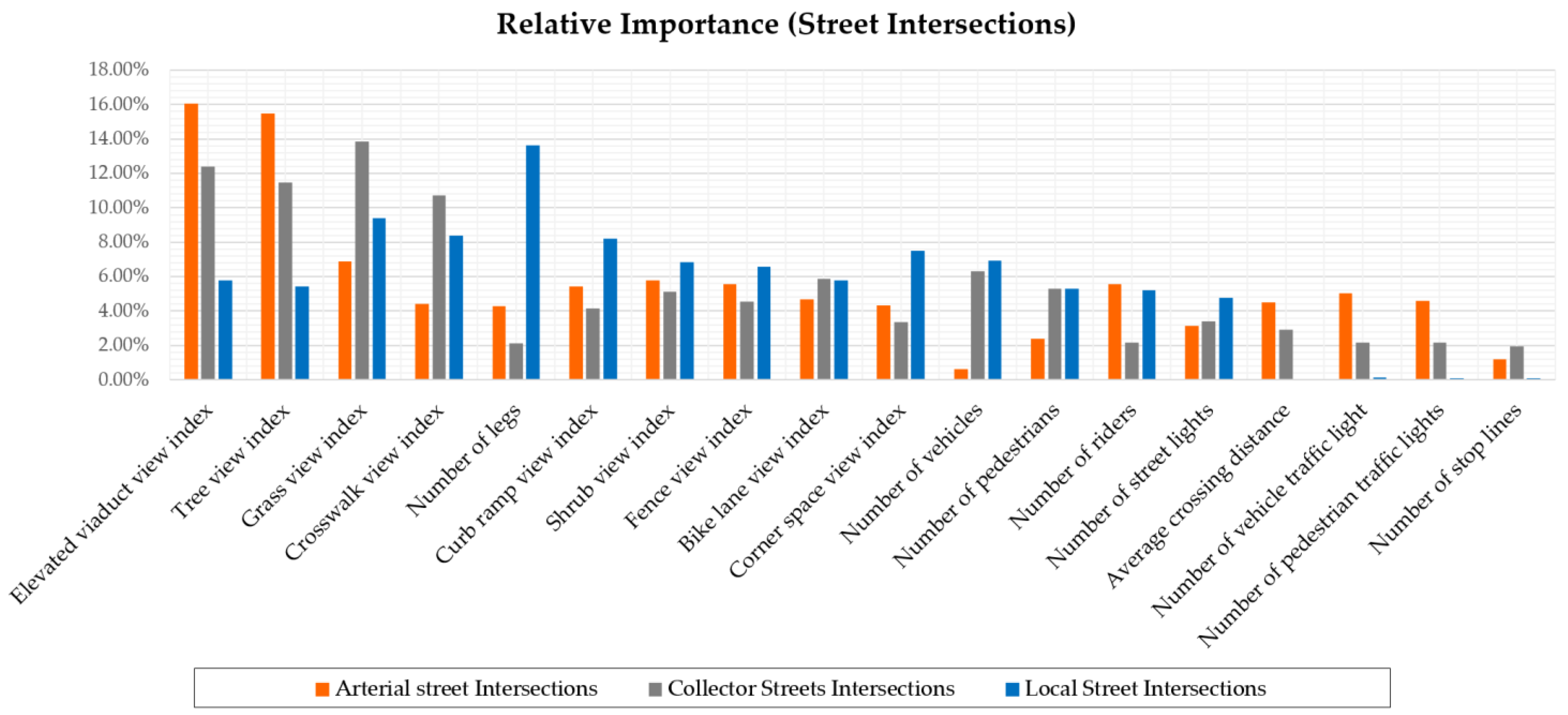
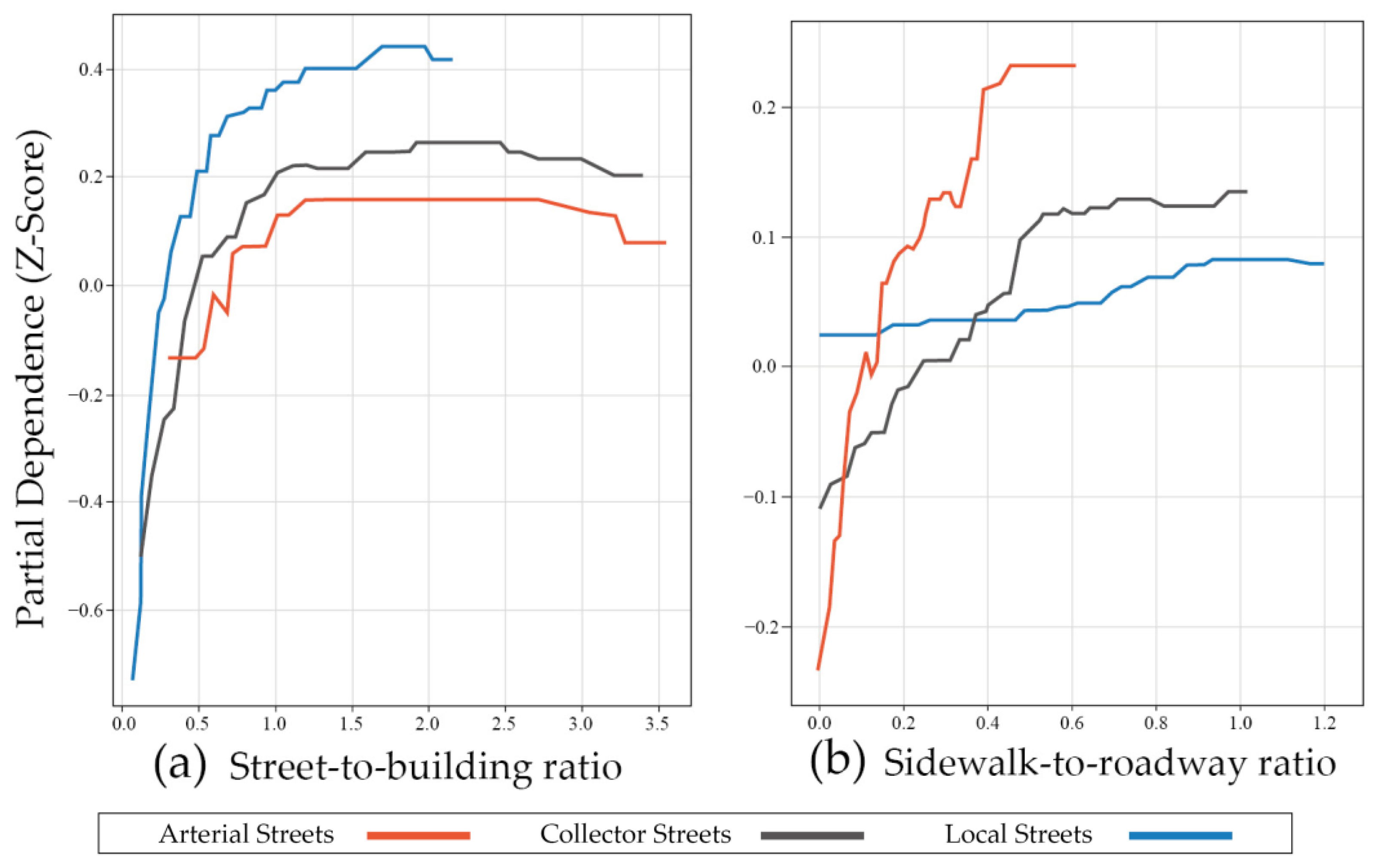
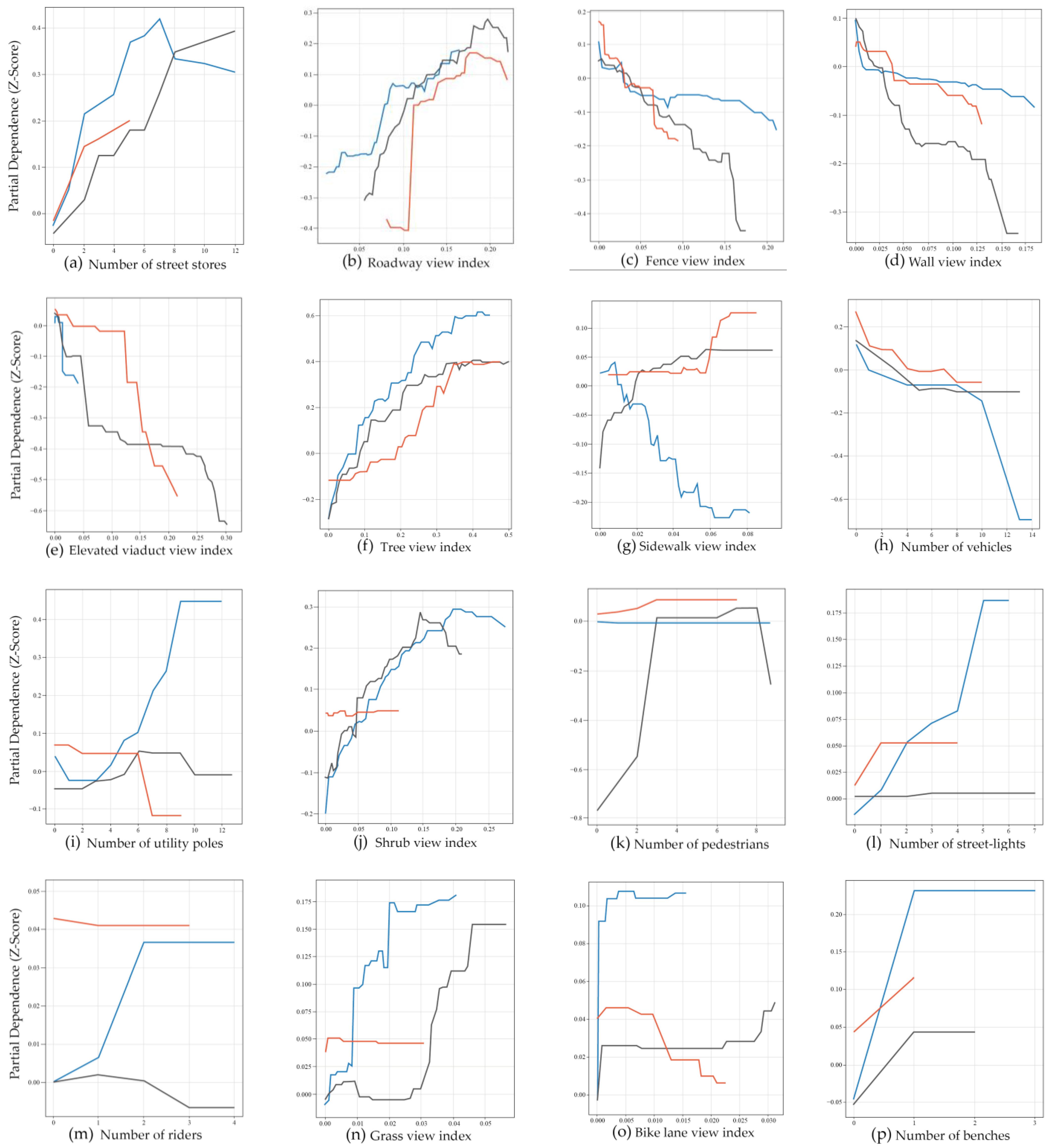

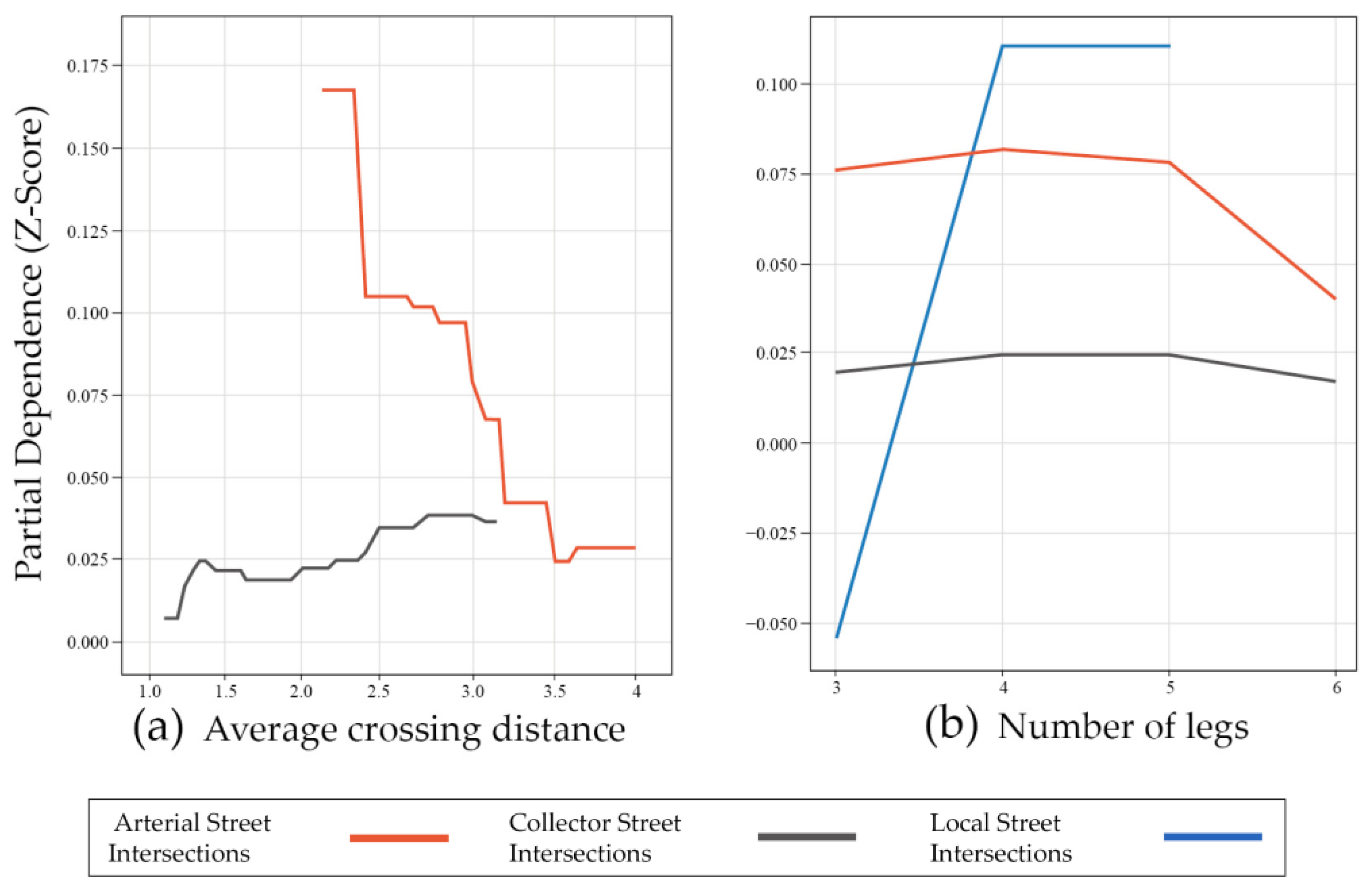

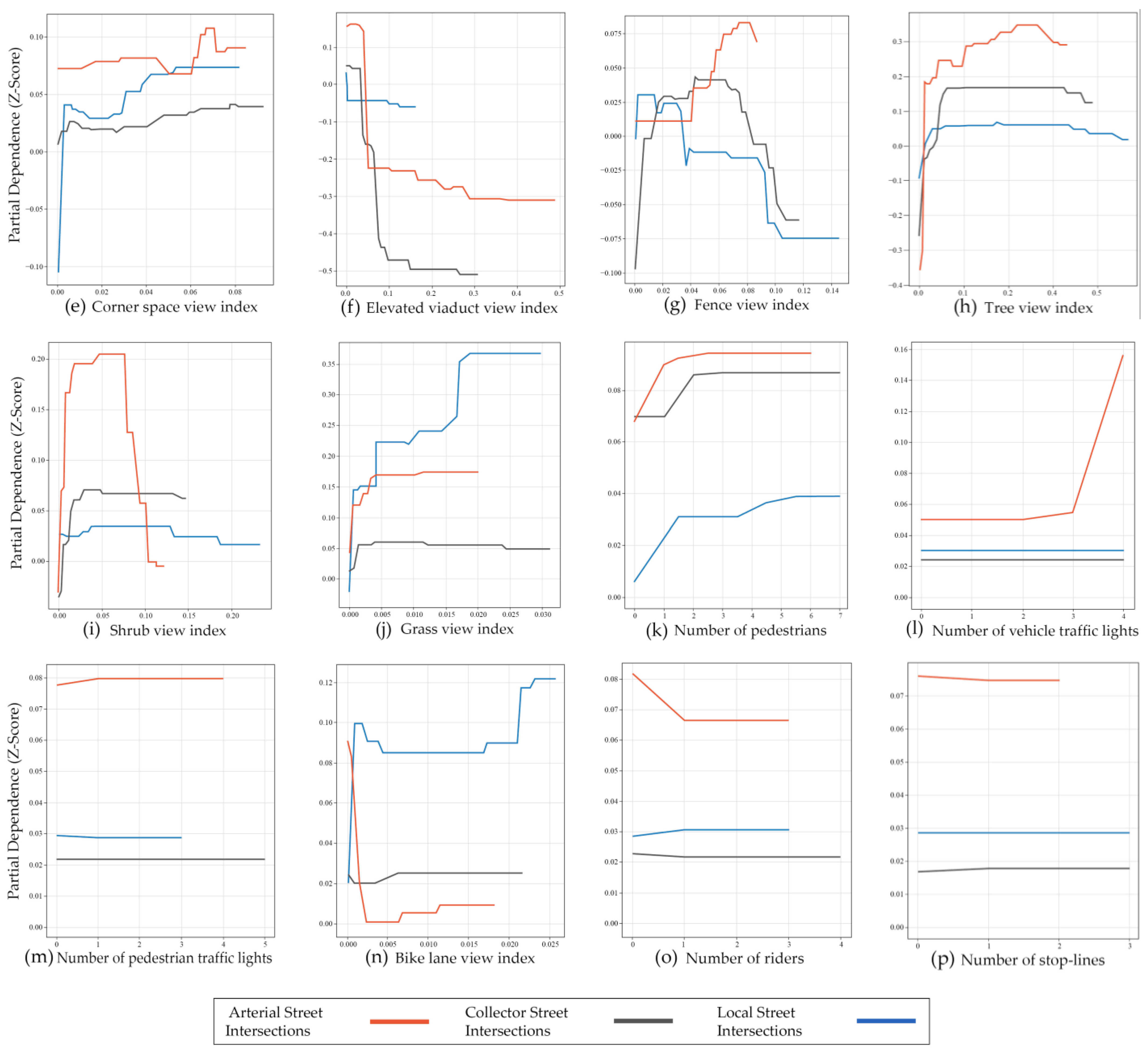
| Category | Width | Definition | Example |
|---|---|---|---|
| Street Segments | |||
| Arterial street segment | W ≥ 13 m | Arterial streets constitute the basic framework of national road transportation as public roads, with the majority including bicycle lanes and pedestrian sidewalks. |  |
| Collector street segment | 5.5 m ≤ W < 13 m | Collector streets constitute the major roads forming the basic network of the road transportation system, with most of these roads including bicycle lanes and pedestrian sidewalks. | 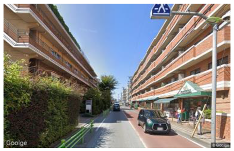 |
| Local street segment | 3 m ≤ W < 5.5 m | Local streets serve mainly local traffic with short trip lengths. Streets of this class are usually formed in a disorderly manner adjacent to residential areas. There are few streets with bicycle and pedestrian sidewalks along the roadside. | 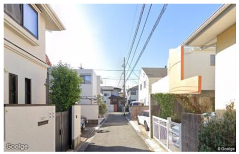 |
| Street Intersection | |||
| Arterial street intersection | The widest leg ≥ 13 m | The intersection is crossed by an arterial street and serves as a crucial node for the urban backbone street network. Such intersections typically have well-developed crossing facilities and traffic signals. | 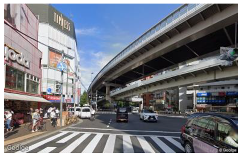 |
| Collector street intersection | The widest leg falls within the range 5.5 m ≤ W < 13 m | The intersection is crossed by a collector street and serves as a vital node for the neighborhood backbone road network. These intersections typically have well-developed crossing facilities and traffic signals in most cases. |  |
| Local street intersection | The widest leg falls within the range 3 m ≤ W < 5.5 m | The intersection is crossed by a local street and forms part of the branching structure of the neighborhood street network. These intersections sometimes have crossing facilities and traffic signals. | 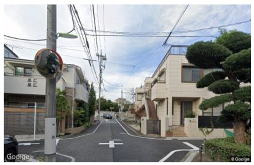 |
| No | Variable | Description | Data Source | Mean | Std | ||||
|---|---|---|---|---|---|---|---|---|---|
| Arterial | Collector | Local | Arterial | Collector | Local | ||||
| Skeletal streetscape | |||||||||
| 1 | Street-to-building ratio | Ratio of the street view index to the building view index | GSV | 0.894 | 0.712 | 0.387 | 0.544 | 0.609 | 0.379 |
| 2 | Sidewalk-to-roadway ratio | Ratio of the sidewalk view index to the roadway view index | GSV | 0.252 | 0.285 | 0.234 | 0.150 | 0.239 | 0.272 |
| Detailed streetscape | |||||||||
| 3 | Elevated viaduct view index | Proportion of pixels of the elevated viaduct category in the image. | GSV | 0.005 | 0.013 | 0.002 | 0.030 | 0.059 | 0.022 |
| 4 | Wall view index | Proportion of pixels of the wall category in the image. | GSV | 0.010 | 0.026 | 0.041 | 0.017 | 0.036 | 0.041 |
| 5 | Fence view index | Proportion of pixels of the fence category in the image. | GSV | 0.023 | 0.031 | 0.038 | 0.019 | 0.038 | 0.044 |
| 6 | Sidewalk view index | Proportion of pixels of the sidewalk category in the image. | GSV | 0.038 | 0.030 | 0.012 | 0.020 | 0.024 | 0.019 |
| 7 | Roadway view index | Proportion of pixels of the roadway category in the image. | GSV | 0.145 | 0.118 | 0.181 | 0.025 | 0.033 | 0.026 |
| 8 | Tree view index | Proportion of pixels of the tree category in the image. | GSV | 0.176 | 0.098 | 0.088 | 0.116 | 0.113 | 0.108 |
| 9 | Shrub view index | Proportion of pixels of the shrub category in the image. | GSV | 0.024 | 0.037 | 0.053 | 0.026 | 0.045 | 0.062 |
| 10 | Grass view index | Proportion of pixels of the grass category in the image. | GSV | 0.001 | 0.003 | 0.001 | 0.005 | 0.010 | 0.008 |
| 11 | Number of street stores | Number of street stores detected in the image. | GSV | 0.718 | 0.652 | 0.155 | 1.025 | 1.018 | 0.656 |
| 12 | Number of utility poles | Number of utility poles detected in the image. | GSV | 3.015 | 3.536 | 3.323 | 1.879 | 2.135 | 1.748 |
| 13 | Number of street lights | Number of street lights detected in the image. | GSV | 0.989 | 0.883 | 0.597 | 0.817 | 0.894 | 0.699 |
| 14 | Bike lane view index | Proportion of pixels of the bike lane category in the image. | GSV | 0.001 | 0.001 | 0.001 | 0.004 | 0.004 | 0.002 |
| 15 | Number of benches | Number of benches detected in the image. | GSV | 0.010 | 0.003 | 0.003 | 0.100 | 0.058 | 0.065 |
| 16 | Number of trash-cans | Number of trash-cans detected in the image. | GSV | 0.020 | 0.032 | 0.054 | 0.150 | 0.198 | 0.254 |
| 17 | Number of awnings | Number of awnings detected in the image. | GSV | 0.029 | 0.018 | 0.007 | 0.169 | 0.156 | 0.089 |
| 18 | Number of mailboxes | Number of mailboxes detected in the image. | GSV | 0.002 | 0.009 | 0.025 | 0.050 | 0.099 | 0.160 |
| 19 | Number of banners | Number of banners detected in the image. | GSV | 0.125 | 0.097 | 0.045 | 0.394 | 0.374 | 0.258 |
| 20 | Number of riders | Number of riders detected in the image. | GSV | 0.263 | 0.162 | 0.075 | 0.553 | 0.435 | 0.291 |
| 21 | Number of vehicles | Number of vehicles detected in the image. | GSV | 4.119 | 2.911 | 1.748 | 2.066 | 2.203 | 1.594 |
| 22 | Number of pedestrians | Number of pedestrians detected in the image. | GSV | 0.898 | 0.606 | 0.367 | 1.136 | 1.010 | 0.758 |
| No | Variable | Description | Data Source | Mean | Std | ||||
|---|---|---|---|---|---|---|---|---|---|
| Arterial | Collector | Local | Arterial | Collector | Local | ||||
| Skeletal streetscape | |||||||||
| 1 | Average crossing distance | Mean length that pedestrians need to cover to traverse the intersection from one side to the other. | DRM | 3.342 | 2.133 | 1 | 1.215 | 0.931 | 0 |
| 2 | Number of legs | Total count of segments that intersect at a particular crossing point. | DRM | 3.709 | 3.677 | 3.488 | 0.550 | 0.528 | 0.513 |
| Detailed streetscape | |||||||||
| 3 | Elevated viaduct view index | Proportion of pixels of the elevated viaduct category in the image. | GSV | 0.040 | 0.013 | 0.003 | 0.106 | 0.058 | 0.028 |
| 4 | Corner space view index | Proportion of pixels of the corner space category in the image. | GSV | 0.033 | 0.033 | 0.020 | 0.018 | 0.021 | 0.017 |
| 5 | Fence view index | Proportion of pixels of the fence category in the image. | GSV | 0.015 | 0.021 | 0.030 | 0.017 | 0.025 | 0.033 |
| 6 | Crosswalk view index | Proportion of pixels of the crosswalk category in the image. | GSV | 0.033 | 0.023 | 0.003 | 0.027 | 0.021 | 0.010 |
| 7 | Curb ramp view index | Proportion of pixels of the curb ramp category in the image. | GSV | 0.002 | 0.002 | 0.001 | 0.001 | 0.002 | 0.001 |
| 8 | Number of vehicle traffic lights | Number of vehicle traffic lights detected in the image. | GSV | 1.118 | 0.709 | 0.042 | 0.891 | 0.922 | 0.270 |
| 9 | Number of pedestrian traffic lights | Number of pedestrian traffic lights detected in the image. | GSV | 0.610 | 0.428 | 0.018 | 0.780 | 0.775 | 0.164 |
| 10 | Bike lane view index | Proportion of pixels of the bike lane category in the image. | GSV | 0.001 | 0.001 | 0.001 | 0.003 | 0.004 | 0.005 |
| 11 | Number of stop lines | Number of stop lines detected in the image. | GSV | 0.348 | 0.334 | 0.305 | 0.496 | 0.507 | 0.493 |
| 12 | Number of street lights | Number of street lights detected in the image. | GSV | 0.877 | 0.751 | 0.674 | 0.711 | 0.770 | 0.727 |
| 13 | Tree view index | Proportion of pixels of the tree category in the image. | GSV | 0.069 | 0.071 | 0.088 | 0.074 | 0.084 | 0.102 |
| 14 | Shrub view index | Proportion of pixels of the shrub category in the image. | GSV | 0.012 | 0.025 | 0.048 | 0.020 | 0.033 | 0.052 |
| 15 | Grass view index | Proportion of pixels of the grass category in the image. | GSV | 0.001 | 0.001 | 0.001 | 0.003 | 0.006 | 0.007 |
| 16 | Number of riders | Number of riders detected in the image. | GSV | 0.465 | 0.269 | 0.105 | 0.707 | 0.548 | 0.345 |
| 17 | Number of vehicles | Number of vehicles detected in the image. | GSV | 3.903 | 2.585 | 1.620 | 1.848 | 1.942 | 1.471 |
| 18 | Number of pedestrians | Number of pedestrians detected in the image. | GSV | 1.069 | 0.751 | 0.458 | 1.213 | 1.092 | 0.842 |
| Arterial (Segment) | Collector (Segment) | Local (Segment) | Arterial (Intersection) | Collector (Intersection) | Local (Intersection) | |
|---|---|---|---|---|---|---|
| Gamma | 0 | 0.1 | 0.1 | 0.1 | 0 | 0.1 |
| Learning_rate | 0.01 | 0.1 | 0.1 | 0.01 | 0.01 | 0.01 |
| Max_depth | 4 | 3 | 5 | 4 | 4 | 4 |
| Min_child_weight | 3 | 1 | 3 | 5 | 3 | 5 |
| n_estimators | 200 | 300 | 300 | 300 | 300 | 300 |
| Pseudo R2 | 0.38 | 0.41 | 0.31 | 0.35 | 0.39 | 0.29 |
Disclaimer/Publisher’s Note: The statements, opinions and data contained in all publications are solely those of the individual author(s) and contributor(s) and not of MDPI and/or the editor(s). MDPI and/or the editor(s) disclaim responsibility for any injury to people or property resulting from any ideas, methods, instructions or products referred to in the content. |
© 2024 by the authors. Licensee MDPI, Basel, Switzerland. This article is an open access article distributed under the terms and conditions of the Creative Commons Attribution (CC BY) license (https://creativecommons.org/licenses/by/4.0/).
Share and Cite
Huang, L.; Oki, T.; Muto, S.; Ogawa, Y. Unveiling the Non-Linear Influence of Eye-Level Streetscape Factors on Walking Preference: Evidence from Tokyo. ISPRS Int. J. Geo-Inf. 2024, 13, 131. https://doi.org/10.3390/ijgi13040131
Huang L, Oki T, Muto S, Ogawa Y. Unveiling the Non-Linear Influence of Eye-Level Streetscape Factors on Walking Preference: Evidence from Tokyo. ISPRS International Journal of Geo-Information. 2024; 13(4):131. https://doi.org/10.3390/ijgi13040131
Chicago/Turabian StyleHuang, Lu, Takuya Oki, Sachio Muto, and Yoshiki Ogawa. 2024. "Unveiling the Non-Linear Influence of Eye-Level Streetscape Factors on Walking Preference: Evidence from Tokyo" ISPRS International Journal of Geo-Information 13, no. 4: 131. https://doi.org/10.3390/ijgi13040131






